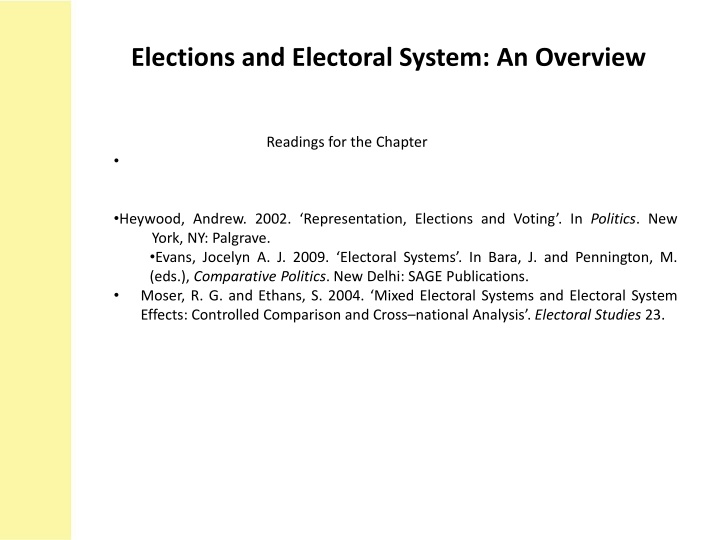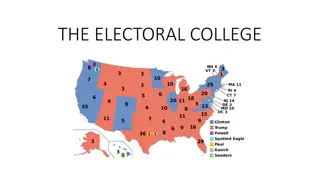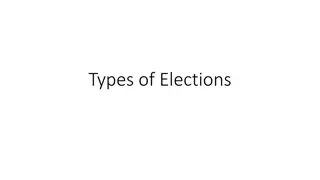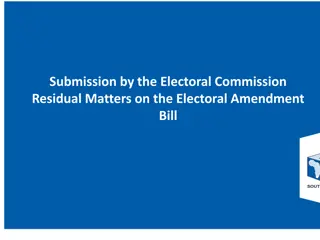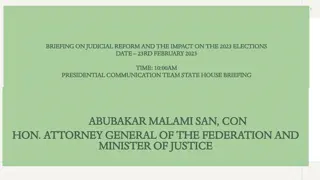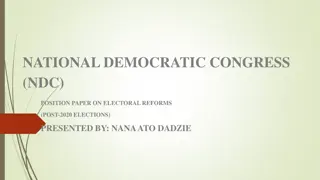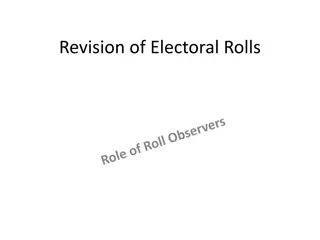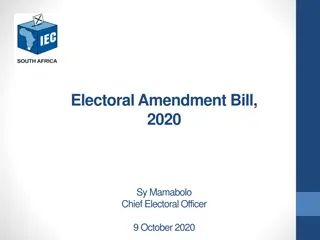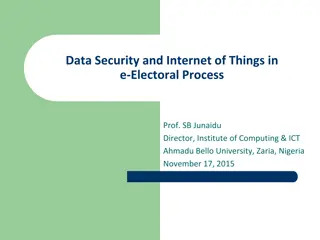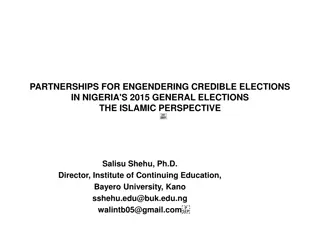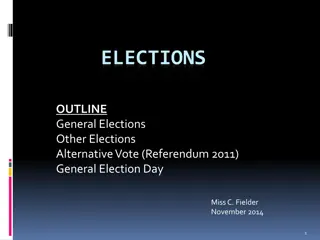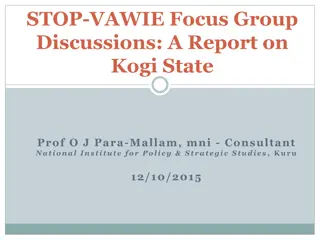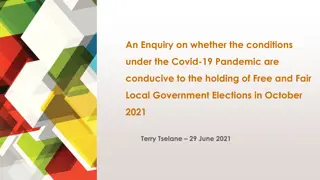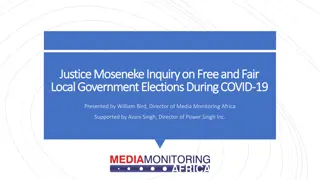Elections and Electoral Systems
Elections and Electoral Systems play a crucial role in modern representative governments, influencing governance, policy-making, and the relationship between the electorate and political elites. The concept of representation, theories of voting, and different electoral systems such as Plurality Majoritarian and Mixed Representation are explored. Single-Member Plurality System (SMD) is discussed as a common electoral system used in English-speaking countries. Advantages of the First-Past-the-Post (FPTP) system are highlighted, emphasizing the principle of one person, one vote. Electoral Systems define how votes are cast, counted, and translated into legislative seats worldwide.
Download Presentation

Please find below an Image/Link to download the presentation.
The content on the website is provided AS IS for your information and personal use only. It may not be sold, licensed, or shared on other websites without obtaining consent from the author.If you encounter any issues during the download, it is possible that the publisher has removed the file from their server.
You are allowed to download the files provided on this website for personal or commercial use, subject to the condition that they are used lawfully. All files are the property of their respective owners.
The content on the website is provided AS IS for your information and personal use only. It may not be sold, licensed, or shared on other websites without obtaining consent from the author.
E N D
Presentation Transcript
Elections and Electoral System: An Overview Readings for the Chapter Heywood, Andrew. 2002. Representation, Elections and Voting . In Politics. New York, NY: Palgrave. Evans, Jocelyn A. J. 2009. ElectoralSystems . In Bara, J. and Pennington, M. (eds.), Comparative Politics. New Delhi: SAGE Publications. Moser, R. G. and Ethans, S. 2004. Mixed Electoral Systems and Electoral System Effects: Controlled Comparison and Cross national Analysis . Electoral Studies 23.
Election Definition: Mechanism by which modern representative system of governments choose individuals or group of individuals for legislature or council (sometimes even for the executive and judiciary posts) Intrinsic relation between election, representation and democracy Notion of Representation Theories of representation: Trusteeship model, delegate model, mandate model and resemblance model Theories of voting: Party identification model, sociological model, rational choice model and dominant ideology model Representative Politics (Evans Jocelyn) Microcosm model Principal agent model Functions of Election (Harrop and Miller) The bottom-up function: Political recruitment Representation Making the government Influencing policy and so on The top-down function: In providing a means through which government and political elites can control and mould the electorate to make it conducive to its governance, generating favourable public opinion and so on
Electoral System Definition: Electoral system is the rules that decide how votes are cast, counted and translated into seats in legislature, and these system vary widely around the world. They govern the conduct of elections. (O Neil, Patrick H., 2004) Kinds of electoral system Plurality majoritarian system: FPTP PR Mixed representation
Single-Member Plurality System (SMD): First Pass the Post Is a system in which the candidate(s) with the most votes are declared elected; there is no requirement that the winner gains an absolute majority of votes. The term first pass the post (FPTP) is coined as an analogy to horse racing, where the winner of the race is the first passing a particular point (the post). Electoral constituencies are structured as single-member districts usually of equal size. Single-member district plurality or FPTP is also known as the winner takes it all . Once a candidate gets the majority of the votes, after that all other candidates lose automatically. Used mostly in English-speaking world: United Kingdom, United States of America, Canada, India, Nigeria and so on.
Advantages of FPTP The principle of one person, one vote is maintained. Strong link between the constituency and the representative thus ensuring that the mandate is carried out effectively. Clear choice is offered to the electorate. FPTP achieves moderation by minimizing a situation of election of a candidate having extreme views. Two-party systems are thought to produce stable, strong and effective government. The government is formed by a single party that is in majority and administration becomes smooth and efficient.
Disadvantages of FPTP FPTP results in tactical voting or compromised voting. For example if there are five candidates A, B, C, D, E. If A and C are expected to win, there may be a situation that a voter prefers D to A, B, C and E, still the voter will prefer to vote either A or C instead of D as he/she will not like to waste his/her vote and have no impact on the final verdict. (Example of US presidential election of 2002 in which Al Gore lost very closely to G. W. Bush.) Wastage of votes (cast for the losing candidate and those cast for winning ones over the plurality mark). Gerrymandering Exclusionary, not truly representative.
Gerrymandering Dots represent voters; lines represent electoral districts. The diagram to the left represents a fair (ungerrymandered) election. The other diagram shows how gerrymandering can tilt the odds to favour one side.
Effect on Voting and Election: Duvergers Law Direct correlation between the electoral system and the party system: Plurality rule election system/FPTP tends to produce two-party systems. PR tends to favour multiparty system. The double ballot majoritarian system promotes multiple parties aligned into two camps. Exceptions: India, Canada
Proportional Representation (PR) Number of seats won by the party/group of individuals will be proportionate to the votes they received. For example in a pure proportional system, if a party secures 35 per cent of the votes, it will gain 35 per cent of the seats. Used to elect an assembly or council. Reasonable alternative to single-member plurality system like FPTP. PR systems provide opportunities and conditions to marginal parties to be part of the governance process. More inclusive, representative and democratic. Ongoing debate in most of the countries following the majoritarian system to move towards greater proportionality. Examples: Canadian provinces such as British Columbia, Ontario and Quebec.
Different Methods of PR System: Party-list Proportional System Parties compile the list of candidates to offer before the electorate. Political parties are emphasized and not individual candidates. Two types: Open list (OL) system and closed list (CL) system. In OL system, the voters may indicate their order of preference within the list. Example: Older democracies such as Finland, Sweden and Netherlands. In a CL system, they can vote for a complete list, it is the party that reserves the right to determine the order of the candidates. Example: Newer democracies like Russia and South Africa. In PR the concept of district magnitude (DM) is important. Larger DM ensures greater proportionality and diversity.
Single Transferrable Vote System (STV) Used in multi-member constituency and engages ranked or preferential voting Also called Hare-Clark system Employs the threshold of quotas as the criteria of election of the candidate called Droop formula: Totalnumbersof votescast Quota Numberof seatstobefilled 1 = + 1 + For example, if there 20,000 votes cast for 4 seats in a constituency, then the quota will be 20000/(4+1)+1=4001. Votes are counted from the first preferences If not all seats are filled, the candidate at the bottom are eliminated and that candidate s votes are redistributed to rest according to the second preferences and so on Used in Republic of Ireland, Scotland, India (Upper House), Australia, New Zealand and Malta
Advantages of STV High proportional outcomes are ensured. It enables the people to exclusively cast their vote in favour of the candidate they like the most. It totally checks the wastage of the votes. The reputation and efforts of candidate matters, bringing competition within the party and thus improving the overall quality of the representatives. Multi-member constituency ensures that public has lot of options for approaching any member they feel comfortable with.
Disadvantages of STV: The intra-party rivalry may be detrimental to the overall orientation and productivity of the party. This system tries to encompass all political party players mostly resulting in coalitions that may not be effective or may not last long.
Mixed representation: Additional Member System (AMS) AMS combines the technique of plurality system as well as PR system. Some proportion is filled by FPTP and some by the party-list PR system. Voters have two votes, one for the political party and other for the candidate. Four characteristics distinguish mixed system: Linkage/compensatory seats, the ratio of seats in each tier, the electoral formula, the district magnitude and legal threshold of the PR tier. Followed in Germany, Italy, Scotland and Wales.
Advantages of AMS AMS offers a beautiful combination of both electoral systems the plurality majoritarian system and PR system, thereby balancing each other. The mechanical effect of FPTP is counterchecked by the inclusive and encompassing orientation of PR system. Disadvantages Presence of single-member plurality system hinders the objective of achieving proportionality. Parties dominate the scene and determine which candidates will get a place in the party list.
Dilemma We must remember Kenneth Arrow s impossibility Theorem that proves that no method can simultaneously obtain all properties desirable in a voting system.
Model Questions What is the significance of election in political process? Critically analyse the different types of electoral system like FPTP, Proportional Representation and Mixed Representation. Do you agree with Duverger s correlation between the electoral system and political parties in a country? Elaborate upon the relative advantages and disadvantages of the majoritarian electoral system like FPTP and Proportional systems.
